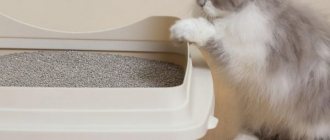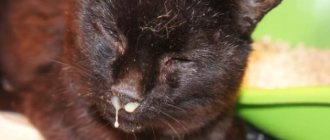What is otitis media in cats?
Otitis in cats, depending on its severity, can pose a serious problem for a domestic cat or be mild. There are three types of otitis in cats :
- internal is the most severe form of the disease;
- external;
- average.
A doctor can most accurately determine the type of disease. Signs of otitis media in a cat are :
- unusual behavior of the animal or changes in the behavior of the pet;
- itching;
- refusal of food;
- head shaking;
- rubbing ears with paws.
More complex forms of the disease are accompanied by the discharge of pus, redness of the ears, baldness of this part of the body, and the appearance of black accumulations in the ears. Failure to treat your pet in a timely manner entails destruction of the eardrum and ear tissues and leads to further deafness in the cat. Excess pus can seep into the body rather than outside, which often leads to death.
This is interesting: How to give Itraconazole to a cat?
how to give ear drops to a cat
Is it possible to give Otipax to a cat?
Otipax is a combination drug intended for topical use in the form of ear drops. This drug, if Otipax is dripped correctly, has an anti-inflammatory, local anesthetic (local anesthetic) and antiseptic (disinfecting) effect. For effective and correct treatment with Otipax, you need to know how to drip Otipax correctly.
Otipax in the form of drops is prescribed by medical specialists for barotraumatic otitis (otitis caused by a sharp change in air pressure), for otitis that appears as a complication after the flu, for acute otitis media (inflammation of the middle ear).
It is correct to use Otipax topically. To do this, the medicine is instilled into the ear, four drops at a time. The procedure is repeated two to three times a day. The duration of treatment with Otipax should not exceed ten days. To avoid irritation of the ear surface with a cold solution, properly warm the container with the drug in your palms before use.
There are practically no side effects observed with the drug Otipax. In rare cases, hyperemia and irritation of the ear canal and allergic reactions are possible. Contraindications for instillation of the drug Otipax: hypersensitivity to the components of the drug, damage to the eardrum.
There are no interactions with other drugs. It is possible to instill the drug Otipax during lactation and pregnancy, but provided that the eardrum is not damaged.
It is correct to undergo an examination by an ENT doctor before starting to use Otipax. It should determine the integrity of your eardrum. With a perforated eardrum, complications may occur due to the effects of Otipax components on the system
Pharmacological characteristics
Combined drug Otipax with local anesthetic and anti-inflammatory effects.
- Lidocaine is a local anesthetic. It disrupts the conduction of pain impulses due to antagonism with sodium and calcium in the nerve fiber membrane. A successful combination of two active substances promotes rapid analgesic action, increases its intensity and duration. The drug stimulates the liquefaction of mucus and its removal from the middle ear cavity through the Eustachian tube and eardrum.
- Phenazone is a non-steroidal anti-inflammatory drug, an analgesic with anti-inflammatory action. Blocks cyclooxygenase and inhibits prostaglandin synthesis.
Otipax is a combination drug, the use of which has two effects at once: anti-inflammatory and local anesthetic.
Lidocaine hydrochloride is a local anesthetic. It causes blocking of impulses traveling along the nerve pathways, and as a result, the area of living tissue exposed to it temporarily loses sensitivity, including becoming insensitive to pain.
When these two components are combined in one preparation, the severity and duration of the analgesic effect increases and inflammation is relieved more quickly. The medicine also helps soften mucus and inflammatory products, which helps remove them from the ear.
The drug has only a local effect; its components are not absorbed into the blood unless the eardrum is damaged.
Local anesthetic - Lidocaine. It prevents the pain impulse from being transmitted to the brain by forming antagonism with calcium and sodium in the nerve fiber membrane.
This combination of Phenazone with Lidocaine promotes the onset of an optimal analgesic effect. Its intensity, as well as its duration, increases significantly. Together they activate the processes of liquefaction of pathological mucus, followed by its removal from the cavity of the ear organ.
The therapeutic effect of the drug Otipax is based on the action of the main components. Lidocaine produces an analgesic effect. Phenazone has an anti-inflammatory and analgesic effect, and is an antipyretic (reduces high body temperature). The combination of two analgesics helps to accelerate the onset of anesthesia and makes it possible to increase its intensity and duration.
Symptoms of otitis media in a cat
Symptoms of otitis in a cat develop as the disease progresses. If characteristic signs occur, your doctor should take your pet to the doctor. The sooner this is done, the better it will be for the animal. At the same time, owners are advised to constantly check their pet’s ears, even if he feels fine. If red areas appear, as well as small black dots, the development of the disease can be suspected at an early stage.
You should consult a doctor if symptoms of otitis media appear in your cat:
- Bad odor coming from the ears.
- Formation of crusts on the ears, which cannot always be removed with ear sticks.
- The animal is trying to scratch its ear. It can do this with its paws and rub its head on the floor.
- Pus that comes out of the ears.
- The appearance of small ulcers.
- Problems with coordination - the animal often sways when walking.
- Restless behavior of a pet.
- The animal is in pain when the owner touches the pet's ears.
Symptoms in cats may vary depending on the severity of the disease. The first signs may appear rather weakly, but if they occur, you need to urgently go to the hospital. The exact symptoms and treatment will be determined by the doctor who will diagnose the pathology.
Medical experts note that there are different types of pathology. To determine treatment, you will need to understand exactly what you are dealing with. First, you should pay attention to the type of disease depending on the location of the lesion.
What types of otitis are there:
- Outer. This is the simplest type and can be treated quickly. In this case, the lesion affects only those areas of the organ that are visible. In this case, the pathology spreads to the eardrum.
- Average. This is a fairly common variety. In this case, the lesion affects the membrane. This type often takes on a chronic form. If the treatment is competent, then the prognosis will be good.
- Interior. This is the most dangerous form of otitis. The pathology affects not only the membrane, but also the vestibular apparatus. The danger is that the disease can affect the meninges, and sepsis can also begin.
When bacterial otitis appears in cats, it can be understood that the causative agent is bacteria. In the case of allergic otitis in cats, you will need to deal with allergies first. Often the disease is seasonal. Fungal otitis also occurs; in this situation, fungi are the causative agent. All types are dangerous in their own way and require immediate medical attention. With purulent otitis in cats there is a high probability of developing negative complications. If you don’t want to lose your pet, you need to start treatment as soon as possible.
Signs of ear disease
The very first sign that something is wrong with your pet’s ears is the cat’s increased interest in the ears: she strokes them, scratches them, slightly covers them and tilts her head slightly towards the affected ear.
These signs indicate otitis externa, and this is a good reason to go to a veterinary hospital!
With otitis media and internal otitis observed:
- sore ears (sometimes prevents you from even touching);
- an increase not only in local temperature, but also in general;
- with a long purulent process, signs of general intoxication - general depression, lack of appetite, vomiting;
- the head is tilted towards the affected ear, slightly bent, the cat often shakes its head and meows at the same time;
- obvious purulent discharge from the ear (especially if the integrity of the eardrum is damaged), a squelching sound is possible when massaging;
- sagging of the eyelid and lip on the affected side if the inflammation affects the facial nerve;
- in particularly protracted cases - purulent dissolution of the ear cartilage and auditory ossicles;
- sudden jumps of the cat and fear due to unexpected painful shootings.
When the disease passes into the chronic stage, the clinical picture may not be so obvious:
- pet anxiety from periodic pain;
- thickening of the skin around the entrance to the hearing aid, as well as near the auditory membrane (visible only during instrumental examination with an otoscope).
Specific symptoms:
- allergic otitis is accompanied by hypersensitivity reactions in other parts of the body (urticaria, itching, swelling, etc.);
- with otitis caused by ear mites, dirty brown discharge is noted, after cleansing of which bleeding ulcers and wounds may remain. Usually both ears get sick at once;
- with otitis caused by the presence of excess moisture in the ear canal, the discharge will always have a liquid consistency, regardless of its characteristics (transparent or cloudy, serous or purulent);
- Fungal and bacterial otitis often has a dirty yellow discharge with a specific odor. Ears are hot. The diagnosis is made on the basis of laboratory cultures, when specific pathogens of the inflammatory process are isolated;
- with otitis media caused by excessive hair growth, hair is found deep in the ear canal. Before starting treatment, the hairs are removed;
- - in case of tumor inflammation or due to the ingress of foreign objects, the immediate causes are revealed during examination - in fact, neoplasms and foreign elements. Usually detected during examination using an otoscope.
Features of the composition
Thanks to the active substance of the drug, phenazone, which blocks cyclooxygenase, the biosynthesis of “anti-inflammatory” PGs slows down. Another active component, lidocaine, blocks the passage of the pain impulse at the level of nerve fiber membranes. Also contains sodium thiosulfate, glycerin, alcohol.
The drug is suitable for treating the ears of cats and dogs if they are found to have mites. The product can be instilled in the same dosages as for otitis media. Otipax will help the animal get rid of itching and pain.
You should not drip Otipax into your cat’s ears if there are such contraindications.:
- the existence of mechanical damage to the eardrum;
- increased sensitivity of the body;
- having an allergy to lidocaine.
Allergic manifestations may be noticed in a cat after using the product as a side effect.
Adverse reactions and overdose
After using the medication, undesirable reactions may occur, namely the appearance of an allergy at the site of use of the drug, the symptoms of which are a burning sensation, peeling of the skin, and redness.
If such signs appear, you should stop treatment and inform your doctor.
The drug is characterized by low adsorption. That is why, if the specified dose is observed, cases of overdose are not permissible. If you neglect the instructions, side reactions may appear in a more pronounced form.
What can cause otitis media in a cat?
You need to know that otitis media means an inflammatory process localized in the ear canal. Accordingly, the inflammation must be provoked by something. Usually the reason lies in:
- foreign body entering the ear;
- allergies (most often food);
- neoplasms (polyps, tumors, papillomas);
- parasite activity (ear mites).
Breeds with floppy ears have an innate predisposition to ear infections.
This is interesting: How to give Almagel for cats?
Rules for using ear drops
Before using any drug, you should carefully read the instructions. It is advisable to take your pet to the veterinarian so that the doctor can help in choosing a medicine.
To increase the effectiveness of treatment, you need to follow some rules:
- before instilling the drug, it is necessary to clean the pet’s ear of crusts and wax;
- when processing, do not insert the cotton swab deeply so as not to damage the eardrum;
- the drops need to be warmed in your hand or in warm water;
- when instilled, the pet’s ear is pulled back, and then you need to press it a little and massage it so that the drug is distributed over the entire surface;
- During the procedure, it is important to praise the dog and then give it a treat.
Otodectosis can affect both cats and dogs, but ear scabies are more common in cats. Ear mites are generally not dangerous to humans, but you can be a carrier and infect your cat or kitten.
A sick cat can pose a danger to other pets, for example, ear mites can spread to a ferret or dog.
Otodectosis (ear scabies) is especially susceptible to young cats (up to one year old) and kittens. But adult cats and female cats can also become infected with ear mites. Usually, ear mites affect both ears at once, but if only one is affected, both ears need to be treated, otherwise the mites will simply change their place of residence.
Ear mites themselves are not very dangerous for cats and can be treated quite easily, but sometimes they may require some effort and persistence from the cat owner during treatment. Otodectosis must be treated immediately after the first symptoms appear in order to prevent complications, which are what pose a threat to the lives of cats and kittens. Due to intense scratching, the blood vessels in the ear can rupture, causing a hematoma, which will require surgical intervention. In the absence of the necessary treatment, the cat will develop otitis media, hearing will gradually disappear, the eardrum may rupture and the inflammatory process will spread to the middle and inner
How to recognize otitis media at an early stage?
Before drops for otitis media are used, the cat must be diagnosed with it. The characteristic features are:
- dirty discharge from the ears;
- squelching sounds inside the ear canal;
- the pet often shakes its head;
- scratches temples and base of ears;
- A foul odor emanates from the ear.
In some cases, small wounds near the temples can already be considered one of the signs of the development of otitis media. Just like a cat won’t scratch itself until it bleeds for no reason.
What drops are most often prescribed for otitis media in cats?
You need to know that otitis media can be successfully treated only if the root cause that caused it is eliminated. The following drops are used as medicinal preparations:
Bars Forte. From the Russian manufacturer Agrovetzashchita. Made on the basis of the active ingredients Miconazole nitrate and Enfloxacin. Due to this, Bars Forte is often prescribed for the treatment of otitis media of fungal and bacterial origin. The use of the drug is not allowed if the integrity of the eardrum is damaged. Before using the product, the auricle is thoroughly cleaned using special products. Next, 1-2 drops are instilled into each ear 2-3 times a day for 7-10 days. After instillation, the pet’s ears are folded and massaged in the temple area. It is better to fix the head for 1-2 minutes so that the animal does not splash the medicine while shaking its head.
Otidez. Another effective anti-otitis drops for cats, which are produced by the Russian company Pchelodar. Made on the basis of Gentamicin and Propolis extract. Thanks to this, Otidez is widely used in the treatment of otitis media caused by fungal, bacterial, allergic or parasitic lesions. The remedy is especially effective in the treatment of acute otitis media caused by the activity of ear mites (otodectosis). Before instilling the product inside the ear canal, it is recommended to clean it using special preparations (Otifri, 8 in 1). If there are none, then you can moisten a cleaning cloth with Otidez and thoroughly wipe the ear canal to clean it of crusts and dirt. After this, 3 drops are instilled into each ear 2 times a day for 3-5 days. The use of Otidez is prohibited at the slightest suspicion of a violation of the integrity of the eardrum. This point can only be confirmed or excluded with the help of an otoscope.
Otibiovin. The most common remedy for otitis media for cats today. Produced in the Czech Republic by Bioveta. It is considered a broad-spectrum drug, as it is effective in the treatment of otitis media of a bacterial, fungal and allergic nature. It is also used as an antibacterial agent in the presence of open wounds and fistulas in the auricle. As for the method of application, the manufacturer strongly recommends clearing the ear canal of secretions and crusts before instilling Otibiovin. To do this, you can use special preparations that are poured inside 2-5 minutes before the procedure. Afterwards, the ears are massaged in the temple area. Then the pet will shake out all the dirt itself. Remains can be collected with a napkin. Next, 3-4 drops of Otibiovin are instilled into each ear at least 2 times a day for a week.
Otipax. Produced by the French company Biocodex. Considered to be effective anti-otitis ear drops for cats of all breeds. Made on the basis of lidocaine and phenazone. Therefore, they are excellent in cases where the ear canal is very inflamed and there are signs of pain when touched. Otipax is most often prescribed for acute and chronic otitis media of allergic or bacterial origin. The duration of the course is 5-10 days, during which 1-2 drops are instilled per day into each ear. The ear canal is first thoroughly cleaned of secretions and wax.
Remember that not all ear drops will be effective for your cat if used without a diagnosis and dosage from a veterinarian. Find time to visit the veterinarian, since the success of the entire treatment depends on determining the type of otitis and eliminating the provoking factor.
Otipax drops for dogs are a medicine for otitis, otodectosis and other ear diseases in pets.
How to instill Otipax correctly
Most children experience otitis from the first days of birth to 3-4 years. The disease also occurs at older ages, as well as in adults. But this happens much less frequently than in preschool children.
For the treatment of otitis, various topical drugs are most often used, and complex therapy is selected aimed at pain relief, destruction of pathogens and inflammation.
Otipax for otitis in children is one of the most common remedies, as it allows you to improve the condition of a small patient in the shortest possible time, has a minimum of contraindications and possible negative consequences. The drug Otipax has a pronounced painkiller and does not enter the bloodstream after use.
Although the drops have a localized local effect, you must follow the rules for their use. How to properly drip Otipax into the ears of a child and an adult, how long the course of treatment should last, read on.
Otipax drug for children
Otipax is a drug whose main active components are two substances:
The drug is available only in the form of ear drops. Otipax is a clear liquid with a not very strong odor of alcohol. The drug is used both independently and as part of complex therapy for various types of otitis media. The product is available in pharmacies without a prescription and is available at an affordable price. You can use Otipax when flying for a child.
How to drip Otipax into a child's ear
Otipax for the prevention of otitis in children is widely used in modern pediatric practice, therefore, every parent should know how to drip Otipax into a child’s ear. The procedure for using the medicine for adults and children is not particularly different - except that when carrying out the procedure, very young children can use turunda.
So, let’s figure out how to instill Otipax correctly so that the therapy brings maximum results and does not cause harm to health. The duration of use of the product is selected individually, but most often does not exceed 8-10 days.
To get the maximum therapeutic effect, you need to instill the drug into the ear canal correctly:
- Before you start using the product, you must install the dropper included in the kit of the purchased product on the bottle. In the future, you should avoid touching the tip of clothing and other objects.
- Before use, the product must be heated in a water bath to a comfortable temperature or simply in your hands. Cold drops cannot be used!
- Place the person on the opposite side, and then drop the required amount of the drug into the ear canal of the affected ear. Typically, children under one year old need 1-2 drops of the drug once a day in each ear, from a year to 3 - 1-3 drops of Otipax several times a day, and over 3 years old - 2-4 drops of the drug 2-3 times a day in each ear. ear.
- After 4-5 minutes, turn the patient over and repeat the procedure with the other ear.
Important! The question often arises of how to drip Otipax into the ear of a child, with whom, due to his age, it is impossible to negotiate so that he lies still. In this case, you need to seek the help of another person.
So, one adult will hold the baby in the desired position and calm him down so that he is not afraid of the procedure, and the other will instill the drug.
How to properly drip Otipax into the ears of an adult - by heating the bottle or not? It all depends on the severity of the pain - if it is strong, it is recommended to warm the drops a little; if it is weak, you can use the solution in any form. For adults, 1-3 drops of the solution are injected directly into the ear canal using a pipette; children are recommended to use turundas - first 1-2 drops of the product are applied to a piece of cotton wool, and then the compress is placed in the ear.
How long does it take for Otipax to work?
How long after Otipax begins to act depends on the individual sensitivity of the body to the active components of the drug - on average it is 15-30 minutes. Drops belong to the category of local anesthetics.
Now you know how quickly Otipax helps and how to properly administer it to an adult or child.
Rate:
(Total: 1 / 5.00) Loading…
StopOtit.ru » Medicines
Caring for a cat during treatment
A sick cat must be looked after until the otitis media passes. In this case, there will be a chance to improve your well-being and avoid negative consequences. The veterinarian will explain in detail what exactly the person needs to do.
You can carefully examine the ears at home to observe for pus and tenderness. If necessary, you can carefully remove excess hair near the ear. To remove crusts, you will need to moisten a cotton swab with hydrogen peroxide and then wash the auricle. Wounds must be smeared with anti-germ gels.
At home, you can instill 2 drops of products such as Otipax or Otinum into your ears. These drugs are from a human pharmacy, so you don’t need to look for them in a pet store. When treating otitis in a cat at home, it is important to monitor how the disease develops. At the same time, it is worth remembering what you should never do with an animal.
First of all, it is forbidden to clean your ears yourself if you have no experience in this matter. There is also no need to warm the affected ears, so as not to aggravate the situation. If the animal gets worse, then you should immediately consult a doctor. You may need to reconsider your treatment regimen.
Otitis in a cat: symptoms, treatment, causes, how to properly clean ears
Otitis media is a common disease in cats. These animals are more susceptible than dogs to the development of meningitis and deafness due to long-term inflammatory processes in the ears, so it is important not only to be able to recognize the onset of otitis media in cats (symptoms), but also to be able to prevent this condition.
Feline otitis: general information and causes
The hearing organ of a mustachioed pet consists of 3 sections - the outer ear, the middle and the inner. Inflammation is classified according to the inflammation of a particular department.
Otitis externa occurs most often and is cured most easily, relatively quickly and mostly without complications. But if there is a delay in contacting a veterinarian or improper treatment, the inflammation easily spreads to the internal parts.
With otitis media, recovery occurs without complications only with timely diagnosis and proper treatment. Deep otitis or otitis of the inner ear is the most dangerous pathology, which has the most consequences and complications (deafness and meningitis), not excluding cases of death.
Cats of all breeds and ages suffer from otitis media. There is no specific breed predisposition, but there is a high incidence of cases in old and weakened animals.
Hypothermia.
Rain and drafts are the clear enemies of cats. If water gets into the ears, it stagnates and becomes an excellent environment for the development of pathogenic bacteria. When hypothermia occurs, the animal's immunity decreases.
Otitis in dogs and cats. Treatment methods for otitis media in dogs and cats (continued)
Treatment of otitis in dogs and cats
depends on the severity of symptoms and the cause of the disease.
As a rule, therapy comes down to general treatment and local treatment. General treatment mainly includes the correct selection of antimicrobial drugs (antibiotics), if necessary. Local treatment consists of sanitizing the auricle and ear canal
and using a variety of anti-inflammatory drops. Let's give a few examples.
Treatment option for otitis media No. 1
Wipe with hydrogen peroxide 2 times a day - up to 14 days. Wipe the inside of the ear
and ear canal, removing crusts, ichor and purulent discharge until completely clean. The cotton swab should be damp and nothing should get inside the ear canal.
Chlorhexidine 2 times a day - up to 14 days. We wipe the inside of the ear and ear canal, previously treated with peroxide. The cotton swab should be damp and nothing should get inside the ear canal.
Lubricate the inside of the dog's ear with Bepanten or Celestoderm or DE (DK) Cream (vet.) 2 times a day - up to 14 days. In more complex cases, you can use ointments such as Fluorocort, Cortomycetin, Lorinden, etc.
Otitis treatment option No. 2
Wipe with hydrogen peroxide 2 times a day - up to 14 days. We wipe the inside of the ear and ear canal, removing crusts, ichor and purulent discharge until completely clean. The cotton swab should be damp and nothing should get inside the ear canal.
Most dog owners have experienced that their beloved pets become restless, and excessive plaque forms in the ears and an unpleasant odor appears.
In such situations, we want to quickly help our four-legged friend and often we turn to our own first aid kit, which contains a proven remedy such as Otipax. But can it be used on a dog and in what doses? Let's figure it out.
- Acute otitis media.
- Otitis media in the acute period (at the time of inflammation).
- Otitis, as a complication after colds.
- Barotraumatic otitis.
The effectiveness of the drug is due to the combination of two components: phenazone from the group of non-steroidal anti-inflammatory drugs and lidocaine, a local anesthetic. Thanks to these components, Otipax quickly relieves pain (after 5-7 minutes the patient feels relief).
The French medical company conducted a number of studies and the drops were found safe for pregnant women and children from birth. In this regard, most veterinarians consider these drops an acceptable option for treating pets, in particular dogs. However, before use, you should consult a specialist.
Important.
If you have an ear infection, you should not self-medicate. The symptoms of otitis media and ear mite infestation are very similar, but the treatment for these diseases is radically different.
Typically, dogs, regardless of breed, are instilled with 4 drops in each ear, 2-3 times a day (depending on the severity of ear damage). The course of treatment is no more than 10 days.
Before use, it is recommended to ensure the integrity of the dog’s eardrum. The use of Otipax in the case of a perforated membrane is associated with various complications due to the contact of active substances with the components that make up the middle ear.
Analogs
If it is impossible to use Otipax in the treatment of ear pain and inflammation for some reason, the doctor will recommend drops. They contain the same active compounds, are prescribed for the same indications and are allowed at any age. In addition, this drug is cheaper.
In addition to Otirelax, children may be prescribed the following medications for otitis:
- . This local antibiotic is prescribed for otitis media and is used even if the eardrum is torn. A doctor can prescribe it at any age.
- . This drug reduces pain and helps fight inflammation due to the content of choline salicylate. It is used in children over one year of age.
- . The effect of this drug is due to a combination of anesthetic and antibacterial substances. It can be dripped into the ears of children 1 year and older.
- . In this medicine for otitis media, antibiotics are supplemented with glucocorticoid hormone. The medication is in demand in pediatrics, as it is approved from 1 month.
- . This drug is also based on a combination of compounds with an antibacterial effect with a glucocorticoid. It is used in children of any age.
You can learn how to properly place drops in a child’s ears in the following video.
Composition and action
The basis of ear drops is:
- phenazone;
- lidocaine hydrochloride;
- sodium thiosulfate.
Phenazone is a substance that has an anti-inflammatory effect and also reduces pain in the hearing organ. Phenazone belongs to the group of antipyretics and has an analgesic effect. It has the ability to reduce capillary permeability and prevent the development of an inflammatory reaction. Its analgesic and antipyretic properties are similar to aspirin. As part of ear drops, it reduces pain, stops the inflammatory process and reduces local temperature.
Lidocaine is a popular and highly effective anesthetic, and sodium salt reduces swelling well and has an anti-inflammatory effect. In addition, sodium thiosulfate relieves the manifestations of an allergic reaction and has an antiparasitic effect, therefore Otipax is prescribed for otodectosis, infection with ear mites.
Important!
The components of the drug have contraindications for use, so Otipax ear drops are not recommended for self-medication.
Types of ear pain
Pain in the ears can manifest itself in different ways. The specificity of pain acts as one of the guidelines in determining pathology.
Nature and intensity of ear pain:
- Sudden pain. Accompanied by acute pain, it can be caused by injury or a foreign object;
- Progressive pain. It occurs against the background of pathologies with moderate dynamics of development. May indicate wax plug, inflammation in the ear canal;
- Severe pain in the ear, accompanied by throbbing. Character for boil, OVSU, injury;
- Stitching, sharp. The pain occurs periodically, bringing with it discomfort. The main reason is neuralgia;
- Blunt pain. Manifests against the background of diffuse otitis, may indicate the presence of sulfur plugs, inflammation of the middle section in a chronic form;
- Itchy pain. Relevant for those cases when we are talking about damage to the external part. May be caused by otitis media, disruption of the integrity of the ear canal, eczema;
- Intermittent. This kind of sensation is characteristic of radiating pain;
- When swallowing. Causes: OVSU, malignant tumors of the oral cavity and larynx, pharyngitis, tonsillitis.
Purpose
Otipax ENT drops are used for ear diseases associated with inflammatory processes in the hearing organ of pets and infection with ear parasites.
The main indication for use of the drug is otitis media. This is a group of inflammatory diseases of the hearing organ in dogs. Depending on which area is affected, external, middle and internal otitis are distinguished. The causes of the pathology may be different, but the disease occurs due to damage to the outer ear:
- with tick bites;
- formation of sulfur plugs;
- allergic reactions to food, medications, cosmetics, etc.
Important!
You should especially monitor the health of the hearing organ in dogs with long ears.
Symptoms of otitis media in pets are:
- redness of the inside of the ear;
- purulent, bloody discharge, often accompanied by an unpleasant odor from the ears;
- hearing loss.
Secondary signs of ear pathologies may be:
- inflammation of the submandibular lymph nodes;
- difficulty eating solid foods;
- discomfort with wide yawning;
- discharge from the eyes and others.
Depending on the causes and location of the disease, the types of otitis differ:
Price and analogues
The medicine is available without a prescription and can be purchased at any pharmacy. The average price per package fluctuates around 250 rubles. depending on the region.
The drug has a number of complete analogues, i.e. medicines identical in composition and released in the same form. These are Lorotox, Maxicold Ototita and Otirelax.
Lorotox is found in pharmacies and in smaller packaging: an 8 mg bottle. Among the listed medications, Otirelax is of Romanian origin, the rest are domestic. The drugs are approximately similar in price; the cheapest analogue is Maxicold Ototita. Indications for use are identical for all.
Among the incomplete analogues, alcohol-based ear drops Otinum are noted. The main active ingredient is choline salicylate. The medicine has bactericidal and antifungal activity. The local analgesic effect is less pronounced compared to Otipax.
The drug Otinum has contraindications that Otipax does not have: chronic respiratory diseases, pregnancy and lactation, as well as the age of the animal under 1 year.
Otipax is a complex drug with great therapeutic potential. Buyers appreciate it for its availability, speed of effect and safety. Veterinarians most often prescribe this particular remedy for the treatment of otitis media in animals.
Appearance
| Purulent | Purulent contents with a foul odor leak from the ears. An advanced stage of the disease can lead to ulcerative processes and perforation of the eardrum; |
| Bacterial | The cause of the development of inflammatory processes is pathogenic microorganisms - staphylococci, streptococci, Escherichia coli and Pseudomonas aeruginosa. The disease can occur in acute or chronic form; |
| Fungal (otomycosis) | It develops as an independent or secondary disease. The pathology is accompanied by swelling, purulent discharge from the ear, which has a sour, unpleasant odor; |
| Allergic | The cause is an allergic reaction or hormonal imbalance. In pathology, earwax is released abundantly, and pathogenic fungi actively multiply in the microflora. The allergy is accompanied by severe itching, the dog scratches its ears, resulting in the formation of ulcers and open wounds. Purulent contents are discharged from the ears. |
Most often, the disease affects the outer ear and is manifested by inflammation of the hair follicle. When the ear canal becomes infected, eczema, swelling, and itching are observed.
Contraindications
People who have perforated eardrums or have increased susceptibility to the constituent components should avoid taking the drug. If there are ear injuries, then taking medication can only worsen the situation.
It is also not recommended for athletes to take before the start of competitions, since the elements present in the composition may show a positive response when tested for doping.
Particular caution should be taken when taking the medicine during pregnancy and breastfeeding.
Dosage
Otipax drops are not a veterinary drug; it was developed and recommended for the treatment of humans, but it helps well in the treatment of otitis media in dogs. The medicine can be used as first aid if symptoms characteristic of ear diseases are noticed:
- the pet is restless;
- shakes his head;
- tilts his head when walking;
- rolls on the ground.
There may be discharge in the inner part of the ear. A dangerous condition that requires immediate contact with a veterinarian is if the discharge is purulent or bloody or has a foul odor.
Before administering the medicine, you should clean the dog's ears using swabs soaked in lotion. You need to drip the medicine into each ear, even if the pathology develops in only one. Otipax is administered 1-4 drops, depending on the size and weight of the animal. The course of treatment - even if unpleasant symptoms are no longer observed - is from 3-10 days.
Otipax drops have a thick, oily consistency, so their introduction into the ear canal can cause discomfort in the animal: as a result, the dog will try to free itself from the medicine - shaking its head, scratching its ear with its paw. To maintain the therapeutic effect, after instillation, fold the ear in half and lightly massage it.
Can I put it in my ear?
This drug has proven itself as an effective remedy for:
- Acute otitis media.
- Otitis media in the acute period (at the time of inflammation).
- Otitis, as a complication after colds.
- Barotraumatic otitis.
The effectiveness of the drug is due to the combination of two components: phenazone from the group of non-steroidal anti-inflammatory drugs and lidocaine, a local anesthetic. Thanks to these components, Otipax quickly relieves pain (after 5-7 minutes the patient feels relief).
The French medical company conducted a number of studies and the drops were found safe for pregnant women and children from birth. In this regard, most veterinarians consider these drops an acceptable option for treating pets, in particular dogs. However, before use, you should consult a specialist.
Important. If you have an ear infection, you should not self-medicate. The symptoms of otitis media and ear mite infestation are very similar, but the treatment for these diseases is radically different.
Typically, dogs, regardless of breed, are instilled with 4 drops in each ear, 2-3 times a day (depending on the severity of ear damage). The course of treatment is no more than 10 days.
Before use, it is recommended to ensure the integrity of the dog’s eardrum. The use of Otipax in the case of a perforated membrane is associated with various complications due to the contact of active substances with the components that make up the middle ear.
special instructions
Otipax belongs to the category of universal remedies that can be used to treat all family members, even in cases where there is no opportunity to see a doctor, and the patient requires assistance.
However, before starting a course of treatment with this drug, perforation of the eardrum should be excluded, because if it is disrupted, contact of lidocaine and phenazone with parts of the middle ear system can lead to the development of complications. Phenazone, the active substance in Otipax, may give a positive result during a doping test.
The drug interactions of Otipax are not described in the official instructions. This means that no clinically significant combinations were identified. However, the advisability of using any other drug should be discussed with your doctor.
Pregnant, lactating and puppies
Particular attention is always paid to such categories of pets as:
- puppies;
- pregnant individuals;
- nursing dogs.
After all, not all medications are suitable for their treatment. Many of the drugs have many side effects and can negatively affect the health of expectant mothers and babies.
Otipax is a harmless drug with local action (it does not penetrate the body, but acts locally, provided that the eardrum is not damaged). The drug is not an antibiotic; resistance does not develop to it. The medicine is non-toxic and can be used even for newborn puppies, pregnant and lactating dogs.
But we must not forget that, like any drug, there can be an allergic reaction to Otipax (individual intolerance to the constituent components). This phenomenon is extremely rare, but it is still necessary to consult with a veterinarian before use.
For otitis media
Otitis in dogs is an inflammation of the ear in the inner or outer part (auditory canal). If your dog shakes, turns his head or constantly scratches his ears, then these are the first signs of illness.
If you feel an unpleasant odor, this is a reason to start sounding the alarm, because this disease can lead to negative consequences (perforation of the eardrum, tissue changes, hearing loss).
It is important to quickly make a correct diagnosis and prescribe a course of medications and procedures. There are many types of otitis (suppurative otitis media, allergic otitis, etc.), forms and complications, so it is impossible to make an accurate diagnosis at home.
Reference. Fold-eared and short breeds (dachshunds, basset dogs, cocker spaniels) are especially susceptible to otitis. Air does not flow well inside, which creates a warm and humid environment, and these are the best conditions for the proliferation of pathogenic bacteria. In addition, low-set ears practically drag along the ground, which significantly aggravates the situation and contributes to infection.
At the first symptoms of the inflammatory process, you can use Otipax drops; they will quickly relieve pain and inflammation. If the dog has an advanced form of otitis, then complex therapy is necessary; drops alone cannot do it.
Often, in combination with Otipax, rinsing with boric acid, hydrogen peroxide and antibiotics are prescribed. If otitis media is allergic in nature, then treatment includes taking antiallergic drugs and a hypoallergenic diet.
Bacterial otitis: causes, symptoms and treatment
Microbial otitis is secondary in almost all cases. They develop due to hypothermia, water getting into the pet’s ears, damage to the inner surface of the hearing organs, for example, due to improper cleaning with cotton swabs.
The inflammatory process may involve one or both ears. The disease is accompanied by:
- unbearable itching;
- discharge of dirty yellow purulent exudate;
- redness;
- an unpleasant odor that appears due to the fact that the ears are festering.
A sick kitten or adult animal becomes lethargic, apathetic, refuses to eat, and sleeps poorly due to the fact that its ears hurt and constantly itch. Microbial otitis media is treated with antibacterial drugs in the form of injections. Typically, four-legged patients are prescribed penicillins and cephalosporins. The course of antibiotic therapy is 7 days, even if the symptoms of inflammation disappear earlier.
To eliminate itching and pain, ear drops (Otibiovin, Otonazole, Aurikan) are used. To properly instill them at home, you must carefully study the instructions for use. For severe scratching, wound healing ointments (Levomekol, Iruksovetin) are used. If there is heavy purulent discharge, the ear should be washed at the veterinary clinic. If a blockage of the ear canal is detected, the help of a surgeon is sought.
Instructions for use
How many drops should I use?
The dosage of Otipax for otitis is 4-5 drops in each ear, approximately every 8-9 hours, for 7-10 days.
How to give?
It should be noted that drops are instilled only into a clean ear, regardless of the disease. Putting drops into a dirty ear, no matter Otipax or another drug, is useless.
Moreover, this can be harmful, since the microflora quickly adapts to the medicine and begins to produce new resistant strains of bacteria. Don't punish your pet even more, do everything right from the very beginning.
Before instillation, hold the bottle of medicine in your hand so that the drops warm up a little, this way you can avoid frightening the animal and unnecessary resistance.
Reference. Some dog owners advise swaddling the animal first so that everything goes quickly and without complications. However, veterinarians consider these manipulations not rational, since the animal may regard these actions as a threat and behave extremely aggressively.
A dog is an animal that has always been distinguished by its special intelligence and intelligence, therefore, be patient and carefully begin preparing for the procedure. You must be calm and affectionate, then the tailed one will understand that you are not harming him, but want to help.
The animal and you should be comfortable; many prefer to carry out procedures on the floor, on the dog’s favorite rug. Prepare everything you need in advance (cotton swabs, cotton swabs, peroxide or boric alcohol, Otipax, etc.), without sudden movements, slowly instill ear drops.
If he resists
If the animal begins to make uncharacteristic sounds or struggle, you may be causing pain to the dog. You need to change tactics: take a break, offer your pet a treat, or start treating the other ear.
Remember, if the first procedure went without any “excesses,” then the subsequent ones will be simple and painless.
How to use?
The specifics of the course of treatment depend on the severity of the existing disease. According to the general scheme, 2 drops are dripped into each ear twice a day. However, only a qualified doctor will give accurate recommendations.
The required amount of product is determined by various factors: the nature of the disease, associated complications, the age, weight and gender of the pet, and the presence of individual contraindications. In difficult cases, veterinarians allow the dose of the drug to be increased, but not more than doubled.
The course of treatment takes from a week to 10 days, depending on how quickly a stable positive effect is achieved. It can be repeated as prescribed by a doctor. However, if it is necessary to carry out new therapy, it is worth taking a break of 1 week and observing the pet’s condition.
It can be difficult to instill drops, since the animal most often resists aggressively. The liquid tickles the ear openings, causing the cat to feel a foreign body and want to scratch.
Before carrying out the procedure, make sure that the eardrums are not damaged, if necessary, consult a veterinarian. First, hold the bottle in your hand to warm the contents to body temperature. Inject the drug only into a previously cleaned ear, otherwise the therapeutic effect will decrease.
To instill the medicine, lay the cat on its side, clasping it tightly with your arms and fixing its paws: the animal is capable of severely scratching its owner in a fit of rage. There is often advice to swaddle your pet to avoid resistance. But such actions can cause panic in the cat and will only make the situation worse.
To make your ward feel comfortable, you can carry out the procedure in his favorite place at home or on his favorite bedding.
Behave calmly and affectionately, talk to your pet. Instill the drops without haste, without inserting the pipette deep into the ear. Make sure that the liquid gets into the ear canal. Afterwards, lightly massage your ear so that the medicine is evenly distributed inside.











